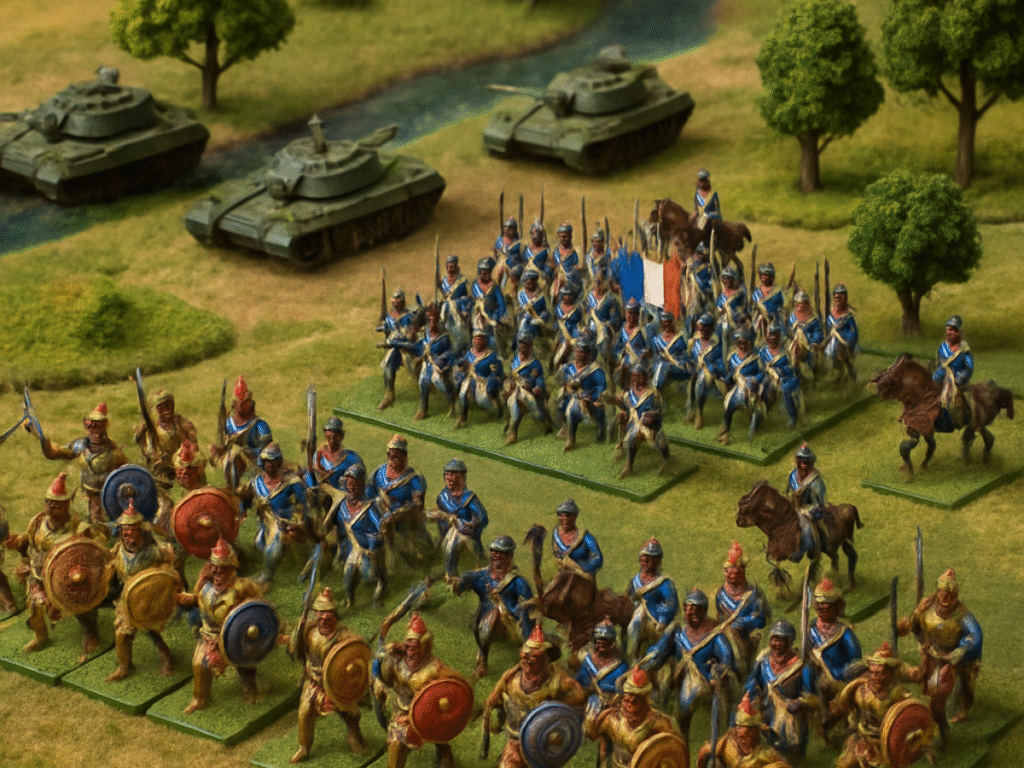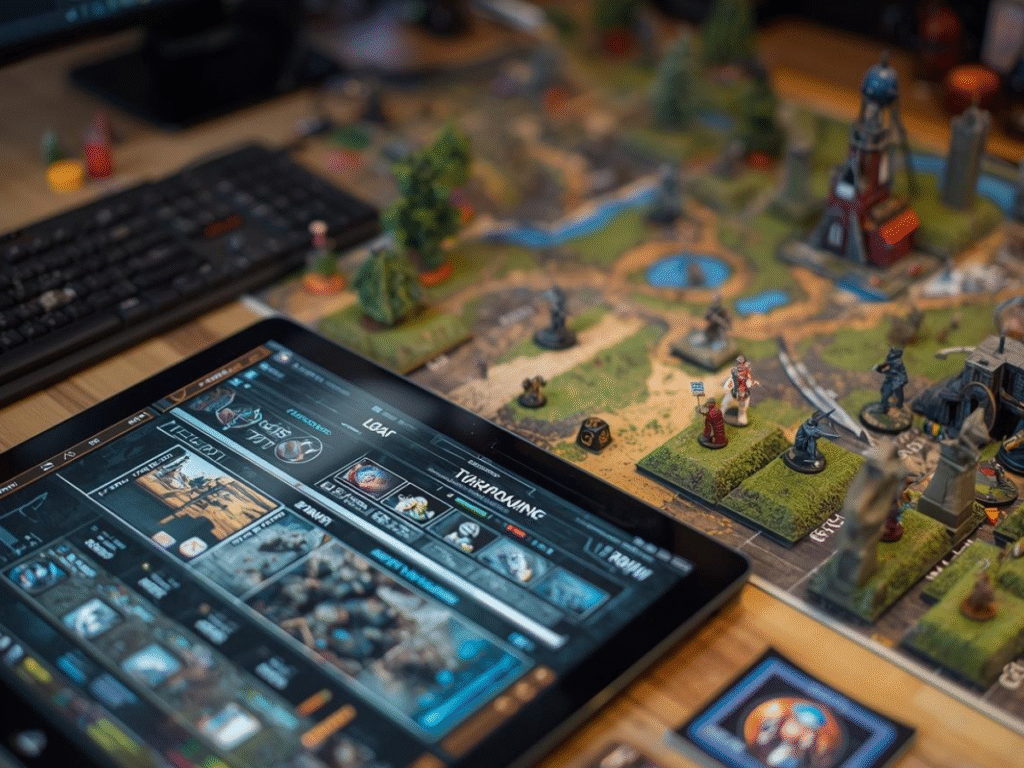With the upcoming release of a new/updated rules for Warlord Games‘ Bolt Action Tabletop wargame rules, I was intrigued with the ‘snippets’ of rules updates that were previewed on their community news feed.
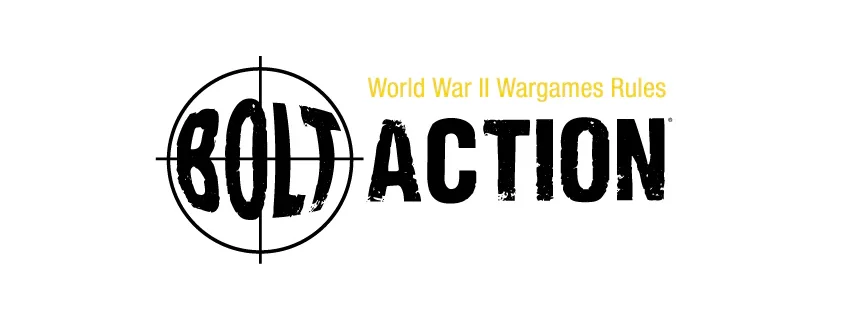
Of most interest were the revised rules that pertained to the Shooting Phase of the game and the Morale factors.
I will discuss these aspects (as I understand them at the moment), as I run through the scenario that I played on Tabletop Simulator recently. I incorporated these revised rules into this scenario and found some interesting effects upon game play.
Playtest Scenario – “A Panther off its leash”
In my demonstration scenario, I pitted a U.S. force, defending a crossroads town inland from the Normandy beaches, against a counterattacking German force.
The Americans had about half of its forces in the town, holding until reinforced by an additional rifle platoon, along with a 76mm Sherman.
Unfortunately, the attacking Germans brought a Panther to ‘the party’… and that is when things got interesting.
Here is a quick overview of the total forces that were involved in this scenario. The reinforcements for both sides began to enter on turn 2 of the 6 turn game. Each reinforcing unit was activated by a single d6 roll, beginning with a ‘six’ on turn 2, decreasing by 1 each turn thereafter. All units were able to join the fight by the last turn.
Unfortunately, for the Americans, their Sherman was a later arrival, while the Panther was in the first turn wave. This gave the Germans time to create some mayhem on the American forces.

The following images shows the initial disposition of the forces (North is Up in the image, towards the beaches).
American troops were set up to defend the town. They hoped for a central approach into the town by the Germans, so the 57mm AT gun was in the northwest corner of the square, behind earthworks in anticipation of their advance.
The small woods to the north and south of the town contained American infantry units, and LMG team, and a 60mm mortar team. Also, a bazooka team was in an ambush position along the northern edge of the town.
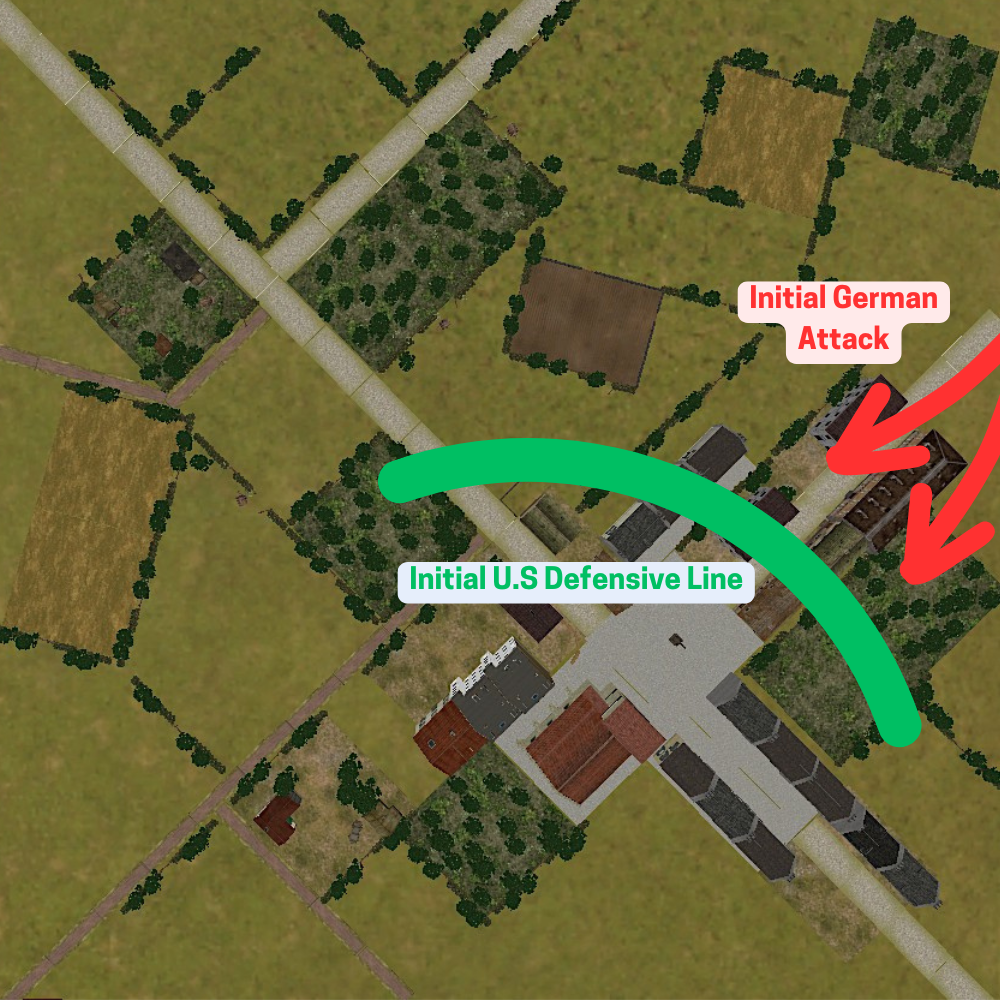
The Americans Draw First Blood
The Germans drove its Puma recon unit down the main street and into the town square, where it was suddenly fired on by the 57mm AT gun in the corner of the square, and put out of action.
Rules note: One of the new rules for Bolt Action 3rd Edition includes a +1 on the fire roll for AT guns, which can help to get the initial ‘hit’ on an armored unit.

With that explosion, the German infantry began to move forward, especially along the southern side of the road into town. This soon put them into fire range for an LMG unit and a squad of Americans set up in the small woods on that side of the road.
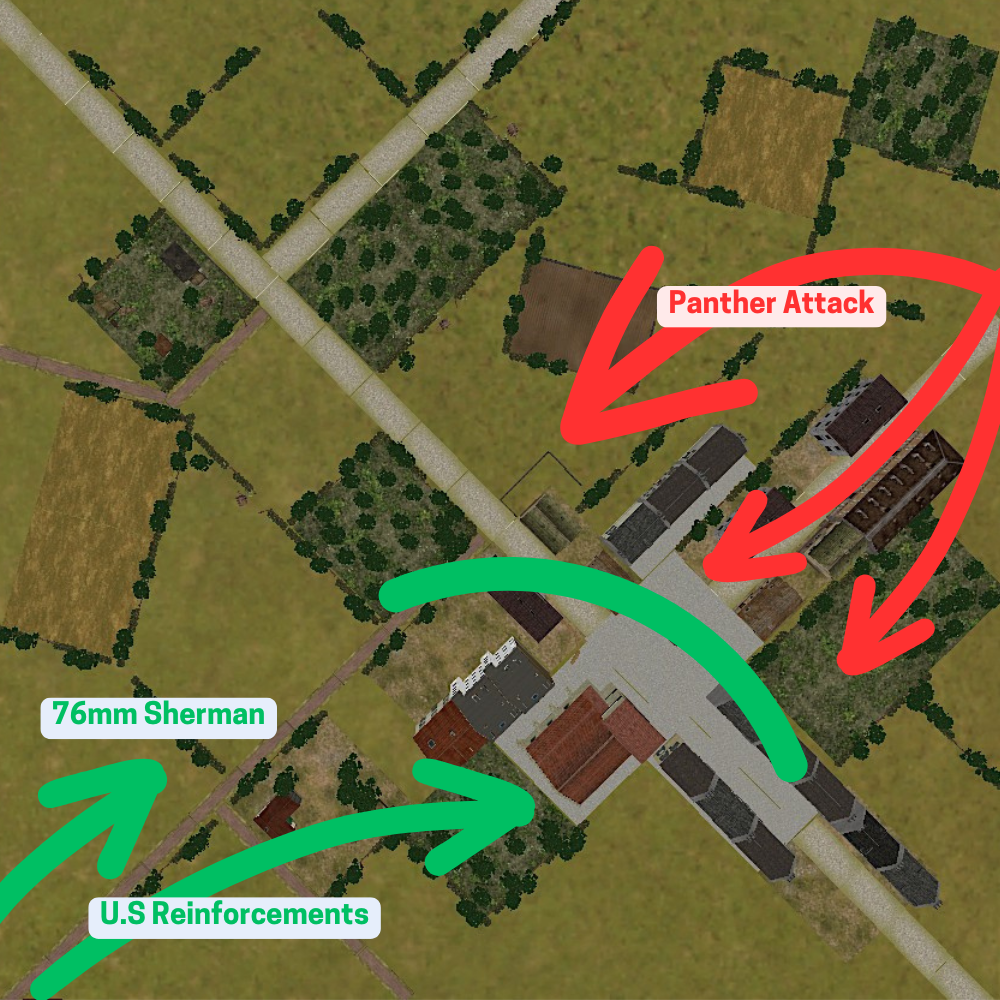
The explosion of the Puma also encouraged the German Panther tank to choose a more open approach route, that might allow for greater turret rotation. It began moving along the open fields on the northern edge of the town.
This movement of the Panther placed it right in the crosshairs of an American bazooka team that was waiting in ambush.
Shooting at a Panther with a ‘Pea Shooter’
The waiting bazooka team was able to get a round off that hit the Panther, but no damage was caused. Of course, this shot brought the wrath of the Panther’s machine guns down on the poor bazooka team. Along with fire from a supporting squad of German infantry, the bazooka team was quickly ‘awarded’ several pins for its efforts.
Rules Note: The new 3rd Edition rules reduces the shots of machine guns mounted on vehicles. the shot count of a vehicle MG is halved. This might be he reason that this bazooka team didn’t get immediately wiped out.
The bazooka team lived on for the next two turns, trying to crawl out of the line of fire. But, eventually, it was wiped out… the first unit casualty of the Americans in this fight.
Rules Note: The new Shooting rules makes it easier to hit a target unit. With a few exceptions (which I will mention later), units hit their target on a 4+ d6 roll. This means that each turn can involve adding a lot of pins to units. Of course, the flip side of this rule is the ‘Roll for Orders’ adjustment. Pinned units roll for their morale check to act on orders without factoring in the number of Pins. So, a single Pin added to a unit might be quickly removed the next order turn.
The American Cavalry Arrives
By turn 3, the next best hope for the American’s defense against the German Panther was the arrival of the 76mm Sherman from the southeast. The 3rd Edition rules do not penalize for long-range fire anymore (only rewarding ‘point blank’ range with a +1 bonus).
So, in the first advance onto the table, the Sherman shot at the Panther. With the +1 bonus for AT fire, the Sherman was able to add a Pin to the Panther. But, the Damage roll was unsuccessful.
With the next fire turn, the Panther shot back at the Sherman and made a ‘glancing’ hit on the Sherman. In the new 3rd edition rules, there are now 2 charts for vehicle damage – one chart called “Superficial Damage” for ‘glancing’ hits that equal the damage roll, and a second chart called “Full Damage” for hit rolls that exceed the damage number.
In the case of the glancing hit on the Sherman, the damage roll caused a brief fire in the tank, which added a second Pin to unit. A Morale roll was required which would determine if the crew panicked and bailed out, or they were able to put out the fire. Luckily for the Americans (for the moment), the crew passed the test, put out the fire, and went ‘Down’ for the rest of the turn.
A Slugfest Was Had By All
The last half of the scenario turned into a Pin fest of sorts. Shots back and forth took its toll on both sides. The Sherman was not very effective against the Panther. But, by the last turn, the Panther had not knocked out the Sherman.
Infantry in the town were running into buildings for cover. The number of Pin markers did not translate into the ‘bloodbath’ that it could have been. And by the last turn, both sides had lost 2 units and were holding their little strip of the town.

Even though there were several American infantry squads moving into the town from behind the church, they lacked the anti-tank capabilities to challenge the Panther just on the northern edge of town.
The battle ended after 6 turns in a stalemate. But, given more turns, one could imagine the Germans would eventually get the upper hand.
Bolt Action 3rd Edition Rules Review
So, how did the new rules impact this game?
Major Changes in Shooting Rules
Well, the changes to the Shooting phase seems to have the largest impact in the new edition. Now there are more steps in the Shooting Procedure.

In addition to the ‘roll to hit’ and ‘roll to damage’, there is a new ‘cover save’ roll that is used if the target unit is either ‘Down’, or in soft or hard cover.
The ‘roll to hit’ modifiers have been greatly reduced. As I mentioned in the AAR above, gone are the ‘long range’ modifier of -1.

Also, changed is the Pin modifier for the shooter. Instead of a -1 fire modifier for EACH Pin, it is just a -1 for ANY Pins. These has a way of keeping a large number of Pins from making a unit totally ineffective.
Some might say that this is unrealistic. Suppression fire is a great way to keep your enemy’s head down. But now, a unit can have 5,6, or 7 Pins, and still potentially put up a strong fire response. So, one might ask “What does a Pin represent in the new 3rd Edition?”
The ‘roll to damage’ is pretty straightforward. The result needed to inflict damage on the target unit starts at a 3+ for inexperienced units and goes up to 11+ for the super-heavy tanks. If your unit does not have any ‘Penetration’ modifier, small arms can only damage infantry, artillery, or soft-skinned vehicles.
But then, for any damage that is inflicted, the target unit can roll a d6 for each damage roll IF they are in soft or hard cover, or they are ‘Down’.

So, this additional roll (a third roll, if you are keeping track) can take the ‘sting’ out of fire attack IF you can keep your more fragile units in some form of cover.
I had many fire attacks in the above scenario where multiple hits were made, with several of those hits causing damage… only to have them neutralized with good Cover Save rolls.
I will be interested in seeing if I am interpreting these rules changes correctly, when I finally get a full 3rd edition.
Changes in Morale and Pins
As mentioned earlier, the effect of Pins on units has changed. Any Pins on a unit has only a -1 modifier on ‘roll to hit’ modifiers.
And as I understand it, the Pins have no effect on Morale rolls. A unit rolls 2d6 for a Morale or Order test and it is a pass if it is equal to or less than the unit’s experience rating.
If a unit passes its Order test, I took 1 Pin off of the unit. This often eliminated the single Pins that were placed on a unit in the previous turn.
A ‘Rally’ would allow a unit to test for Morale in a similar, unmodified way. If the unit passed its Morale test in a ‘Rally’ move, ALL Pins are removed… not the d6+1 rule that applies in the current, 2nd Edition.
A Note About Officers
As I understand it from the news feed, Officer/Command units are more expensive to army building. BUT, they offer more value. Now there are just two levels of officers, but they provide a stronger bonus for surrounding units.

I can see where this can help move units along with a nearby officer.
General Takeaways
The following are my takeaways of the 3rd Edition rules, based on what has been published and how they worked in this one demonstration scenario.
- Pins – I am assuming that only having ‘half of the picture’ of the upcoming rules, I am sure that I have missed some critical factors. That being said, I feel that the new shooting rules creates a lot of Pins, with less destruction of men and materiel – but also, less impact on the unit’s performance. Is that better for the game? I’m not sure. If Pins represent suppression, fatigue, and/or morale loss on the Pinned unit, then I would think that the ‘performance modification’ of Pinned units in this upcoming 3rd Edition might be going in the wrong direction?
- Shooting Rules – Cover Save – I do have a positive feel for the revised shooting rules. It is nice to see an infantry squad in cover not be wiped out by a lucky roll of a handful of dice. The extra “Cover Save’ shooting step does a decent job of adding a bit more protection for those types of troops.
- Additional Vehicle Damage Charts – The additional of a ‘Superficial Damage’ chart to the new edition could be seen as more detail to manage for just a ‘glancing’ hit’. It might have been interesting to make that chart effective for a ‘glancing hit +2″ Penetration roll. But, in this one demonstration scenario, it did not add to the game details
- Army Building – There are other rule changes that have been announced that I did not delve into here that concern transport vehicles, Engineer unit capabilities, and fieldcraft. But, the bigger rules change that many people may be interested in is the army building changes. As I currently understand it, there will need to be one regular rifle platoon for each ‘non-rifle’ unit. This appears to be an attempt to keep specialized units from dominating the battlefield. As I tend to play Bolt Action in Tabletop Simulator, I have less of an issue with this. But, I will be interested in hearing how many miniature collectors out there will see and react to this change.
I would be interested in hearing others experience with the new rules. Have you tried to playtest the new rules (as they have been announced to date)? Do you agree or disagree with my observations? Share your comments below.

